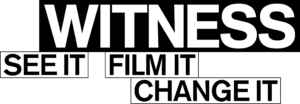Our Impact
WITNESS is the global leader in human rights video. We work side-by-side with local communities to harness the power of video and technology in the fight for justice. One of our partners in Brazil observes that “visibility is the first stepping stone to justice.” With our help, activists have used video to garner awareness and more: to document evidence of war crimes, change discriminatory laws, secure justice for survivors of gender-based violence, and protect indigenous lands against extractive industries.
Since WITNESS’ founding in 1992, our story has been one of ceaseless innovation. In partnership with activists, tech companies, civil rights lawyers, communities, and non-governmental organizations, we have dedicated ourselves to maximizing the potential of the 21st century’s most powerful tools for defending human rights.
After building networks and alliances for nearly 30 years, WITNESS is the hub of a diverse, global community, with collaboration at its heart. Our partners have used our techniques, resources, and technology to help secure a warlord’s conviction at the International Criminal Court; to expose sectarian violence, sex trafficking, and forced evictions; and to establish legal protections for some of the world’s most vulnerable people, from trash pickers in Delhi to elderly Americans at risk of financial, emotional, and physical abuse.
We launched the first-ever online platform to make human rights crimes visible. We established a groundbreaking human rights media lab dedicated to exploring solutions for eyewitness footage to serve as an effective tool for justice and accountability. And we created the first global video-as-evidence guide, teaching activists how to shoot video that meets the standards of legal proof, ensuring that perpetrators can be more than merely exposed – they can also be prosecuted.
Our online resource library offers comprehensive instruction to millions of people about how to shoot, edit, preserve and distribute human rights video for maximum impact. We are always adding to this peerless collection, much of which is currently available in 24 languages.
Our History
In 1988, musician and activist Peter Gabriel traveled with Amnesty International’s Human Rights Now! Tour. While touring, Peter realized that powerful stories of oppression and abuse were being lost, buried, or ignored . . . and that video camera technology could serve as an invaluable tool to capture the truth. Years later, on March 3, 1991, taxi driver Rodney King was savagely beaten by Los Angeles police officers. Witnessing the scene from his balcony, a plumber, George Holliday, took out his brand-new Sony Handycam and pressed record. The clip plainly exposed police brutality and was seen by hundreds of millions of viewers on the nightly news, demonstrating the potential of video to sway public opinion. The following year, Peter, the Reebok Foundation and the Lawyers Committee for Human Rights co-founded WITNESS on the premise that ordinary people using video to expose human rights violations could influence policy and create change.
In our first decade, we provided video equipment and training to a broad range of activists – including those fighting for the rights of women in Afghanistan, forcibly disappeared youth in India, children, and adults with disabilities in Mexico and Paraguay, indigenous peoples in the Philippines, and women trafficked for sex trade in Eastern Europe, among many others. From our earliest days, we listened to frontline human rights defenders about their needs, and developed a collaborative partnership model, cultivating lasting relationships.
As the technology landscape evolved, so did WITNESS. In 2004, Facebook went live. In 2005, the first video was uploaded to YouTube. In 2007, Apple introduced the iPhone. With an agility born of expertise, WITNESS adapted to each of these technological shifts, supplying activists with the tools and knowledge necessary to navigate the digital age. From encryption to verification, live streaming to archiving, we teach human rights defenders how to use video ethically, safely and effectively.
Defending Human Rights Today and Innovating for the Future
As a leading advocate of human rights technology, WITNESS collaborate with developers, social media platforms and technology companies. Together with the Guardian Project, we created ProofMode, an app that adds rich metadata to video, showing where and when a clip was shot, so that it can be trusted by the media and stand up as evidence in court. Another app, ObscuraCam, protects visual anonymity and privacy by blurring the faces of activists and abuse victims.
Our tireless advocacy persuaded Google to integrate its first-ever blurring tool for clips uploaded to YouTube. Human rights defenders can now share videos on the world’s most popular platform while obscuring identifiable details—like facial features, tattoos or street signs—that might otherwise leave their subjects vulnerable to imprisonment or even violence.
These innovations help eyewitnesses document abuses more safely before they share their stories. But WITNESS doesn’t just support activists working behind the camera. In an age when the boundary between citizen and activist is rapidly blurring, our resources guide people everywhere on how to create, share and preserve human rights video more effectively and ethically.
As smartphone use exponentially expands, more and more of the world’s population holds the potential to create change in their pockets. WITNESS—with our pioneering role in human rights video and close relationships with frontline activists, media makers, and technology companies—is uniquely positioned to help people everywhere to harness the power of video. We believe, with the right tools, networks and guidance, anyone, anywhere, can use video and technology to defend human rights. Anyone can be a witness.
